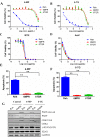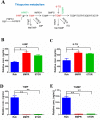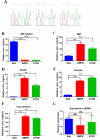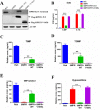HPRT1 activity loss is associated with resistance to thiopurine in ALL
- PMID: 29416770
- PMCID: PMC5788638
- DOI: 10.18632/oncotarget.23405
HPRT1 activity loss is associated with resistance to thiopurine in ALL
Abstract
Acute lymphoblastic leukemia (ALL) is an aggressive hematological tumor resulting from the malignant transformation of lymphoid progenitors. Thiopurine is a widely used drug in the maintaining treatment of ALL. After a period of chemotherapy, 20% of pediatric patients and over 50% of adult patients will relapse. To investigate the mechanisms of drug resistance in vitro, we established the thiopurine resistant cell lines Reh-6MPR (6-MP Resistant cell) and Reh-6TGR (6-TG Resistant cell) by stepwise selection of the ALL cell line Reh. Cell viability assay revealed that 6MPR and 6TGR cells were almost 1000-fold more resistant to thiopurine comparing with the control Reh cells, and thiopurine conversion was significantly impaired in the resistant cells. Mechanistically, a same novel hypoxanthine phosphoribosyl transferase 1 (HPRT1) mutation c.495_496insA (p.V165fs) was found by whole exome sequencing in both resistant cells. The HPRT1 mutation dramaticly decreased the production of [13C5,15N4]-IMP from [13C5,15N4]-hypoxanthine (HX), showed a loss-of-funciton mechanism. Notably, re-expression the wildtype HPRT1 in Reh-6MPR cell can reverse the drug resistance and thiopurine conversion in Reh-6MPR cells. These results highlight the importance of HPRT1's activity in thiopurine resistance.
Keywords: HPRT1 mutation; drug resistance; leukemia; purine metabolism; thiopurine.
Conflict of interest statement
CONFLICTS OF INTEREST The authors declare no conflicts of interest.
Figures





References
-
- Pui CH, Evans WE. Treatment of acute lymphoblastic leukemia. N Engl J Med. 2006;354:166–78. https://doi.org/10.1056/NEJMra052603. - DOI - PubMed
-
- Einsiedel HG, von Stackelberg A, Hartmann R, Fengler R, Schrappe M, Janka-Schaub G, Mann G, Hahlen K, Gobel U, Klingebiel T, Ludwig WD, Henze G. Long-term outcome in children with relapsed ALL by risk-stratified salvage therapy: results of trial acute lymphoblastic leukemia-relapse study of the Berlin-Frankfurt-Munster Group 87. J Clin Oncol. 2005;23:7942–50. https://doi.org/10.1200/JCO.2005.01.1031. - DOI - PubMed
-
- Pui CH, Carroll WL, Meshinchi S, Arceci RJ. Biology, risk stratification, and therapy of pediatric acute leukemias: an update. J Clin Oncol. 2011;29:551–65. https://doi.org/10.1200/jco.2010.30.7405. - DOI - PMC - PubMed
-
- Rivera GK, Zhou Y, Hancock ML, Gajjar A, Rubnitz J, Ribeiro RC, Sandlund JT, Hudson M, Relling M, Evans WE, Pui CH. Bone marrow recurrence after initial intensive treatment for childhood acute lymphoblastic leukemia. Cancer. 2005;103:368–76. https://doi.org/10.1002/cncr.20743. - DOI - PubMed
-
- Karran P, Attard N. Thiopurines in current medical practice: molecular mechanisms and contributions to therapy-related cancer. Nat Rev Cancer. 2008;8:24–36. https://doi.org/10.1038/nrc2292. - DOI - PubMed
LinkOut - more resources
Full Text Sources
Other Literature Sources
Miscellaneous

